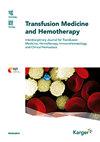在德国范围内对动员能力差的多发性骨髓瘤患者在自体干细胞移植前造血干细胞的动员和收集进行系统研究
IF 1.9
4区 医学
Q3 HEMATOLOGY
引用次数: 1
摘要
& lt; b> & lt; i>简介:& lt; / i> & lt; / b>在有临床指征的自体造血干细胞移植(ASCT)患者中,充分动员CD34<sup>+<前体细胞进入外周血对于确保在强化治疗前收集足够的造血干细胞(HSC)至关重要。然而,在标准的基于粒细胞集落刺激因子(G-CSF)的动员方案中,有重要的少数患者无法动员足够的CD34<sup>+</sup>细胞计数进入外周血,被认为是不良动员(PM)。因为不能获得足够的CD34<sup>+</sup>细胞动员会对重要的临床治疗终点产生负面影响,使用plerixafor (PLX)被批准增加CD34<sup>PM患者的活动。& lt; b> & lt; i>方法:& lt; / i> & lt; / b>德国的一项非介入性、多中心、开放标签、前瞻性OPTIMOB研究评估了成人血液恶性肿瘤(淋巴瘤或多发性骨髓瘤[MM])患者在计划ASCT前的HSC动员策略,重点是PM患者。PM患者定义如下:(1)从未达到≥20 CD34<sup>+</sup>(2)在动员的任何时间点接受PLX,(3)他们最初计划的干细胞产量必须减少,或(4)由于低CD34< +</sup>外周血计数。& lt; b> & lt; i>结果:& lt; / i> & lt; / b>参与OPTIMOB研究的475例MM患者中有168例(35%)被分类为PM,其中155例(92%)在研究期间接受了PLX (PM+PLX)治疗。PM患者年龄在40-78岁之间,男性稍多(<i>n</i>= 97,58%),大多数是新诊断(<i>n</i>= 146,87%),并接受高度个性化的既往治疗。94名pm接受化疗动员(65%),51名患者(35%)仅在第一次动员尝试时接受G-CSF的稳态动员。占PM总人口的92% (<i>n</i>= 155例,其中78% (<i>n</i>= 117)达到>2.0 × 10<sup>6</sup>CD34< sup> + & lt; / sup>采血第1天细胞数/kg体重。PM+PLX的中位总收集结果高于不支持PLX的PM患者(7.2 vs. 5.7 × 10<sup>6</sup>CD34< sup> + & lt; / sup>细胞/公斤体重)。总的来说,136例PM+PLX患者(88%)和8例PM - PLX患者(62%)进行了ASCT检查。& lt; b> & lt; i>结论:& lt; / i> & lt; / b>OPTIMOB研究显示,德国成年MM患者中有相当大比例为pm。尽管在OPTIMOB研究中,大多数pmms都得到了PLX的支持,但PM-PLX也成功地动员了hsc,允许大多数pmms进行ASCT。然而,需要进一步的分析来优化pm中的处理。本文章由计算机程序翻译,如有差异,请以英文原文为准。
A German-Wide Systematic Study on Mobilization and Collection of Hematopoietic Stem Cells in Poor Mobilizer Patients with Multiple Myeloma prior to Autologous Stem Cell Transplantation
Introduction: In patients with a clinical indication for autologous hematopoietic stem cell transplantation (ASCT), sufficient mobilization of CD34+ precursor cells into peripheral blood is essential to ensure adequate hematopoietic stem cell (HSC) collection prior to intensive therapy. However, with standard granulocyte-colony stimulating factor (G-CSF)-based mobilization schemes, an important minority of patients fail to mobilize sufficient (e.g., >10/µL) CD34+ cell counts into the peripheral blood and are considered as poor mobilizers (PM). Because failure to achieve sufficient CD34+ cell mobilization can negatively affect important clinical treatment endpoints, the use of plerixafor (PLX) was approved to increase CD34+ mobilization in PM patients. Methods: The German non-interventional, multicenter, open-label, prospective OPTIMOB study evaluated HSC mobilization strategies prior to planned ASCT in adult patients with hematologic malignancies (lymphomas or multiple myeloma [MM]) focusing on PM patients. PM patients were defined as follows: (1) never achieving ≥20 CD34+ cells/µL before 1st apheresis, (2) receiving PLX at any timepoint of mobilization, (3) their initially planned stem cell yield had to be reduced, or (4) they had not received apheresis due to low CD34+ count in peripheral blood. Results: 168 of 475 MM patients (35%) participating in the OPTIMOB study were classified as PM, and 155 of them (92%) received PLX (PM+PLX) during the study. PM patients were 40–78 years old, slightly more often male (n = 97, 58%), mostly newly diagnosed (n = 146, 87%) and received highly individualized previous treatments. Ninety-four of the PMs underwent chemotherapy mobilization (65%), and 51 patients (35%) received steady-state mobilization with G-CSF only during 1st mobilization attempt. 92% of the total PM population (n = 155) underwent apheresis, 78% of them (n = 117) achieved >2.0 × 106 CD34+ cells/kg body weight on the 1st day of apheresis. PM+PLX had a higher median total collection result than those PM patients without PLX support (7.2 vs. 5.7 × 106 CD34+ cells/kg body weight). In total, ASCT was performed in 136 PM+PLX (88%) versus 8 PM−PLX patients (62%). Conclusion: The OPTIMOB study showed that a considerable proportion of adult MM patients in Germany are PMs. Even though most of PMs were supported with PLX in the OPTIMOB study, PM-PLX also successfully mobilized HSCs, allowing ASCT in majority of all PMs. However, further analyses are required for treatment optimization in PMs.
求助全文
通过发布文献求助,成功后即可免费获取论文全文。
去求助
来源期刊
CiteScore
4.00
自引率
9.10%
发文量
47
审稿时长
6-12 weeks
期刊介绍:
This journal is devoted to all areas of transfusion medicine. These include the quality and security of blood products, therapy with blood components and plasma derivatives, transfusion-related questions in transplantation, stem cell manipulation, therapeutic and diagnostic problems of homeostasis, immuno-hematological investigations, and legal aspects of the production of blood products as well as hemotherapy. Both comprehensive reviews and primary publications that detail the newest work in transfusion medicine and hemotherapy promote the international exchange of knowledge within these disciplines. Consistent with this goal, continuing clinical education is also specifically addressed.

 求助内容:
求助内容: 应助结果提醒方式:
应助结果提醒方式:


